TOKYO (東京)
A full-length book couldn't cover everything there was to see in Tokyo, much less a 4 page list. More than seeing places and sites, though, Tokyo for me was a place to see people--many many people. Though I mentioned a few of Tokyo's districts here and some of the more well known places, no words can quite convey the feeling of being pulled around by crowds or traveling on train with no seats at all--everyone is expected to stand and cram themselves in as best as possible. What I did mention here are some places that are well known and interesting to wander. Hopefully this will give you an idea of what you can look forward to--and eventually inspire you to look further into in a real travel guidebook.
Trains in Tokyo: there are many train lines running through and around the city and while transfers are relatively easy between lines, you sometimes need to buy two separate tickets because the lines are owned by different companies. The easiest way to start (in my opinion) is to stick to the JR Yamanote line (which runs in a loop around the city and has stops at most major areas), and when you are feeling braver venture out to the subway lines, for which you will need to buy separate subway line tickets.
Getting familiar with the Kanji names of places will help with the navigation as well.
Asakusa
(浅草)
|
How to get there: Asakusa is on the end of the subway Ginza line, as well as on the Toei Asakusa line.
What you can find: The big attractions in Asakusa are the temple, Sensoo-ji, and the nearby Asakusa-jinja (Asakusa Shrine), though there are other smaller shrines and temples in the area. The streets near the temples are lined with stands selling snacks, fortunes, amulets, and other omiyage. Though known for the temples, you can also find the Asahi Brewery (also known as the Unko Biru) in the Asakusa area.
My comment: Having heard about the infamous crowds for (o)Shoo-gatsu (or New Years), I visited Asakusa on January 1. I wasn't sure how to get to the temple from the station but I needn't have worried. The crowd started from within the Asakusa subway station and I
|
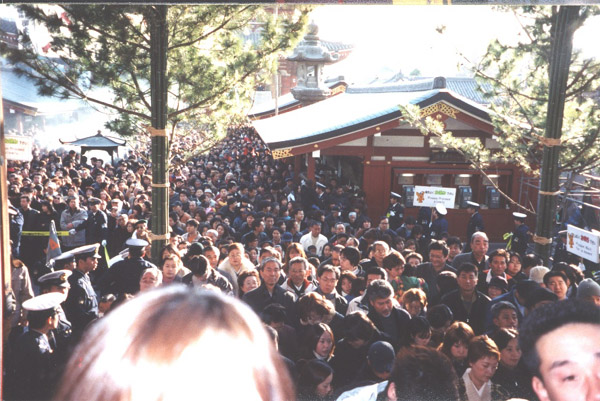
The crowd in front of Sensoo-ji on January 1, 2002.
|
just let myself get pushed up the stairs and out the door and found myself on the main walkway toward the temple. My guidebook said it was a 2 minute walk to the front of the temple but it was a good 30 minute line with the entire walkway packed with people. When I actually reached the front there were policemen guiding the crowd, and a couple policemen standing in metal cages inside the temple speaking through a loudspeaker to keep the crowd moving. The cage was meant to keep the policemen from getting pegged by the coins the people were throwing toward the front, part of the ritual of visiting a temple or shrine. (Don't forget to wear a coat or shirt with a hood in the back, you might find yourself with free money) Many women came dressed in kimonos, Shoo-gatsu is a great time to see Japanese cultural clothing.
Tokyo Tower
(東京タワー)
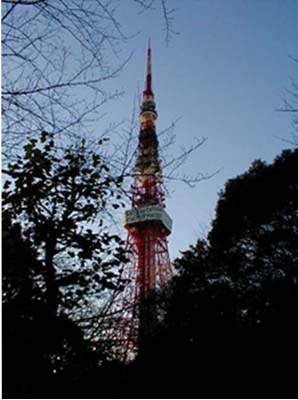
Tokyo Tower
|
How to get there: You can walk to Tokyo Tower from any of several subway stations--Kamiyacho-eki on the Hibiya subway line, Hamamastsucho-eki on the JR Yamanote line, or Akabanebashi-eki on the Ooedo subway line.
What you can find: Tokyo Tower stands 333 meters tall and has two observatories, a waxwork museum, Hollywood Collection (supposedly with Keanu Reeves' Matrix sunglasses), and aquarium. Hours vary by season, and they do not accept credit cards.
Website: www.tokyotower.co.jp
My comment: According to Kato-sensee, Tokyo Tower was not "cool" until recently, when it began to make appearances in popular television dramas. That may explain the long line for the elevators--though it seemed as though most of the crowd was foreign visitors. The view is quite nice from the first level observatory and you can see Roppongi (the clubbing district) down the street, as well as the rest of the city lights. I'm not sure what the view is like during the day, but the guidebooks all seem to mention the city smog...
|
Shibuya
(渋谷)
|
How to get there: Shibuya-eki is a stop on the JR Yamanote line as well as the Ginza, Hanzomon, Inokashira, Shin-Tamagawa, and Tokyu Toyoko subway lines, as well as the Den'entoshi line, which connects to Yokohama.
What you can find: One of the so-called "trend-setter" districts in Tokyo, girls swarm into and out of boutique centers like 109 and around department stores like Parco, OIOI (pronounced Marui), Seibu, and Mark City. Japanese 20-somethings are in and out of Book 1st (huge 5 story bookstore), HMV, (CDs and DVDs), Tokyu Hands ("a creative life store"-- sort of an upscale hardware store). In between these larger complexes you'll find smaller electronic stores, a 100 Yen store (a sort of Japanese dollar store), and clubs like Womb, Club Asia, On Air East and On Air West. Down Dogenzaka (one of the larger streets) you'll also find a large white building--a capsule hotel.
|

The large intersection in front of Shibuya-eki.
(Photo credit http://larve.net/people/hugo).
|
Also down Dogenzaka and its side streets are quite a few "kai-ten" sushi places. Prices vary from Y110 to Y300 a plate, but it's fun to watch the sushi go by on the conveyor belt--and all you have to do is take the ones you want to eat. If you don't see what you want, just ask the chef in the center area for what you'd like to eat, he is always open for orders from customers. You are charged by the number of plates you have in front of you when you get up to leave. What's even better, if you go near closing time they start combining the contents of the plates--you can get 4 or 6 pieces of sushi for the equivalent of a dollar or two. Finally, Shibuya is also known for Hachiko, a small statue of an Akita famed for loyalty to his master. The area around the statue is a popular meeting place.
My comment: I probably spent the most time here than in any other area of Tokyo. I think one of the best places to relax in Shibuya is the Starbucks across the street from the South Exit of Shibuya-eki--there is a second floor seating area (which sometimes has a wait) from which you can sit and look over the huge intersection toward the station. Watching people just pour out of the station every minute can give you a feel for just how many people are in this city. Also, Shibuya and Shinjuku are both definitely places you could go to see the crazy fashions taking over the Japanese youth, and to see where these people go to get their clothes.
Ikebukuro
(池袋)
How to get there: Ikebukuro-eki is on the JR Yamanote and Saikyo lines, as well as the Marunouchi and Yurakucho subway lines. The Narita Express train also stops here on limited service.
What you can find: Ikebukuro is considered (by the guidebooks) the 3rd main subcenter of Tokyo and like the rest of the city, is quite crowded as well. Without even leaving the station you can head straight into the HUGE department store complex of Seibu/Tobu/Parco--and some others. The station itself is a bit confusing as it has over 40 exits leading to different areas. To get to the main center of Ikebukuro, head down Sunshine 60 Street, where you can find a Sanrio shop (Hello Kitty is everywhere in this city...), another HMV, as well as lots of little places to eat. Sunshine City itself, at the end of Sunshine 60 Street, is something of a shopping mall in the basement and first few floors, with some American stores like Eddie Bauer, Gap, and Cinnabon. There is also a planetarium and aquarium--and as it is also one of the tallest buildings in Asia you can take an elevator to the lookout from the 60th floor (for Y620). Ikebukuro is also known for the Toyota Amlux, the world's largest car showroom and the Tokyo Metropolitan Art Space on Ikebukuro's west side, where you can ride what's said to be the world's largest escalator.
My comment: I didn't have too much time in Ikebukuro, but my favorite places were the Seibu/Tobu/Parco department store complex attached to Ikebukuro-eki and the well known Sunshine City building. Also, if you are in need of tissues, the street leading from the station to Sunshine 60 is full of people giving away little tissue packets with advertisements--I came away with about 7 packets, having walked to Sunshine City and back.
Harajuku
(原宿)
|
How to get there: Harajuku-eki is one stop away from Shibuya-eki on the JR Yamanote line, and nearer to the center of everything is the Meiji-Jingumae-eki on the subway Chiyoda line.
What you can find: If you are a Peanuts fan, there is a great store across the street from the northerly JR Harajuku-eki (east) exit selling everything from huroshiki to teapots to stationery to index cards with Snoopy's face on it. As you walk along down Omotesando toward Meiji Doori, you'll pass stores such as J. Crew, Benetton, the ever present Comme ca Mono, and Muji. On Meiji Doori, Gap, New Balance, and Sephora are familiar brand names in the midst of more Japanese boutiques and stores named "It's Demo" (from itsu de mo) and Uniqlo (from the UK). Down the smaller side streets, you can buy anything from accessories to leather pants to fit in with the Japanese fashion, then get in line for the super popular crepes at one of the many crepe stands. On the other side of the JR Harajuku station, Meiji Jingu (Meiji Shrine) is also a popular stop, often very crowded.
|
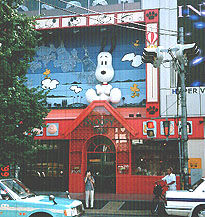
Snoopy store across the street from Harajuku-eki.
|
My comment: I liked Harajuku because it seemed much more relaxed than the crowded Shinjuku and Shibuya areas, while still having the fun youth-type of atmosphere. After winding through narrow and crowded streets elsewhere, it is also refreshing to see large streets for once (Omotesando and Meiji Doori), with large stores that you'd recognize from the US. At the same time, you can wander the smaller side streets and buy yourself an armload of photos of J-Pop singers--or, if you've got the money, tickets to a J-Pop concert. My favorite place to shop was the HUGE Book Off on Meiji Doori, you can get really good deals on used CDs, videos, and books. If you need to check your e-mail, the Giordano store down the street has a few I Macs with internet access for its customers.
Shinjuku
(新宿)
How to get there: Shinjuku-eki is on the JR Yamanote, Chuo, Saikyo, and Sobu lines, as well as on the Marunouchi and Toei subway lines.
What you can find: It is easier to think of Shinjuku in two parts, the east and west sides. The east side is full of--what else--places to shop and eat, including Takashimaya Times Square, Kinokuniya (bookstore), Tiffany's, Isetan and Mitsukoshi department stores, and MyCity. A good place to know is the JR View Travel Service Center, for tourist information. Also in the area is Shinjuku Gyoen, a 144 acre park with both Japanese and French style gardens, a hothouse with tropical plants, and a pond with giant carp. The west side of Shinjuku station is mostly comprised of administrative and governmental offices, though directly by Keio department store are two of Tokyo's largest camera stores: Yodobashi and Sakuraya. Shinjuku Sumitomo Building and Shinjuku NS Building are also sites in the area for shopping and eating. Most guidebooks say something to the effect that Shinjuku is the place to be, to see everything about Tokyo.
My comment: You could probably find everything you've ever heard about Tokyo in Shinjuku--the massive crowds of fashionable (?) teens, "salarymen" and "office ladies," giant TV screens on buildings, an infamous red-light district, immaculate department stores, bars and clubs, shops and restaurants, shrines and parks, and of course lots of neon lights. You could wander this area for weeks and not see everything--I spent an entire afternoon just inside the Takashimaya/Tokyu Hands department store complex.
Ginza
(銀座)
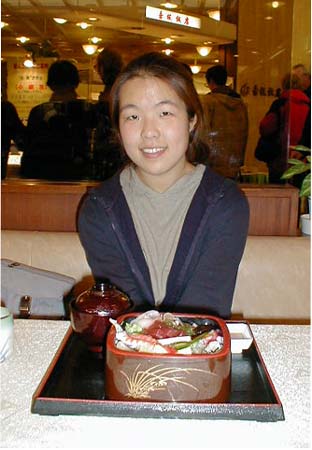
Department Store lunch! and me.
|
How to get there: Ginza-eki is on the Ginza, Hibiya and Marunouchi subway lines, but a good way to tour the area is to detrain at Yurakucho-eki on the JR Yamanote line and walk down.
What you can find: Sundays afternoons are the best time to see Ginza, as the Chuo Doori (the main street in the area) is closed to cars. It's the place to be wowed by richness and high-class society with all the modern trimmings. Some of the best known sights include the Wako clock tower, Sony building, and San-ai building. Kyukyodo is a store known for exquisite stationery--and for marking the spot quoted as Japan's most expensive piece of real estate. Kabuki-za is mentioned in every guidebook as the place to catch an authentic Kabuki performance.
My comment: I think Ginza is one of the easier areas to navigate, it seems to be one of the few areas where the streets are in a grid-style--and what's more, the chome (area) are numbered in order, running down the large main street, Harumi Doori. If Tiffany's, Louis Vuitton and massive department stores are your thing, Ginza is the place to be. It can be intimidatingly expensive but during the lunch hour there are specials in many department stores where you can get a good Japanese style meal at a very reasonable cost--the prices go up for dinner.
|
Akihabara
(�H�t��)
How to get there: Akihabara-eki is on the JR Yamanote line and Hibiya subway line
What is there: Known as Electric Town, most foreigners go to Akihabara to take advantage of the electronics available for sale duty free (tax exempt). Usually the rules include that you bring your passport and purchase something costing more than Y10,000. While the newest products out from Sony, Aiwa, or other large companies are not always available for export, the sheer volume of other fun-looking devices are always something to marvel at.
My comment: I didn't have the chance to go here, but according to the guidebooks I read (under "References") there are supposed to be some pretty good deals on electronics. In a country where it seems like EVERYONE has a cell phone, MD player, and palm pilot, Akihabara Electric Town seems worth the trip just to check things out.
Yokohama
(横浜)
|
How to get there: Tokyo is connected to Yokohama by a number of train lines. One of the cheapest ways of getting there is to take the Toyoko line from Shibuya-eki to Sakuragicho-eki in Yokohama. Many of the sites in Yokohama can be seen more conveniently from Sakuragicho-eki than from Yokohama eki, which is also on the Toyoko line.
What you can find: The main sites in Yokohama include its Chinatown, Sogoo department store (the largest department store in the world), Yamasita Koen, and Minato Mirai 21. Minato Mirai 21 is a new development including Landmark Tower, Japan's tallest building, and Cosmo World amusement park. The distance between Sakuragicho-eki and Landmark Tower can be quickly crossed via a very convenient covered moving walkway. Yokohama Museum of Art is also in the area, there are often signs on the moving walkway letting you of the galleries available there at the time.
|
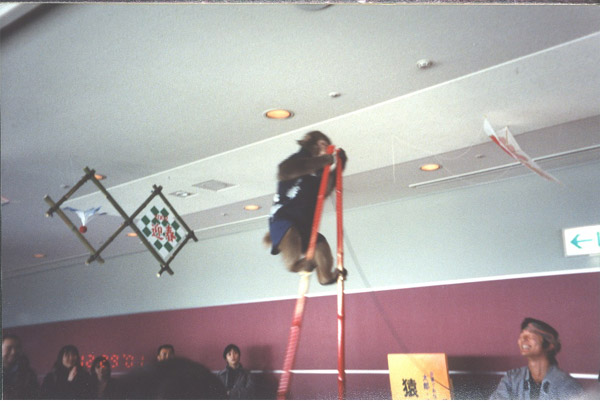
Performing monkey at the Landmark Tower observatory.
|
My comment: I didn't have much time to see Chinatown (Chukagai), but I think the idea of Chinatown in Japan is pretty interesting--it was recommended to me by nearly everyone I asked. The first American-style mall I saw in Japan was in Yokohama, at Landmark Plaza--very similar to the mall here at 900 N. Michigan Ave. The elevator ride to the top of Landmark Plaza (Tower) is an expensive (Y1000) but impressively quick trip, where you can look out to the bay--and out over other buildings. (I saw a lot of helicopter landing pads.) The World Porters shopping center has imported clothes and accessories, and while you're there in the area you can stop by to ride on what is supposedly the world;s tallest ferris wheel, Cosmo Clock 21.
References:
"Lonely Planet" guides: Japan (every backpacker I met had a copy of this!), Tokyo
"Time Out" guide: Tokyo
Tokyo Guide Websites:
www.tokyoessentials.com
www.jnto.go.jp/english/index.html
www.japan-guide.com/
www.asahi-net.or.jp/~by3s-fet/english.htm
www.bento.com/tokyofood.html
One extra note:
As I was traveling on a rather puny budget I stayed at the cheapest hotel I could find--in Tokyo, I found a place called "Economy Hotel New Koyo," (03-3873-0343) a couple subway stops away from Ueno at Minowa-eki. This hotel had 75 single rooms, costing either Y2500 or Y2700 per night, plus a Y1000 key deposit which is returned to you at check out. The rooms were very small--to give you an idea, the small Japanese style rooms were two-tatami-rooms, and the Western style rooms were just big enough for a bed and a little space to move around. However, it was pretty clean and it had internet access, coin laundry, and a small shared kitchen, and best of all, they accepted credit cards. I made my reservation online through their website (www.newkoyo.jp/), and the people at the hotel were very friendly. It's a good place to know, especially when the expenses of travel begin to build up.
A few extra pictures....
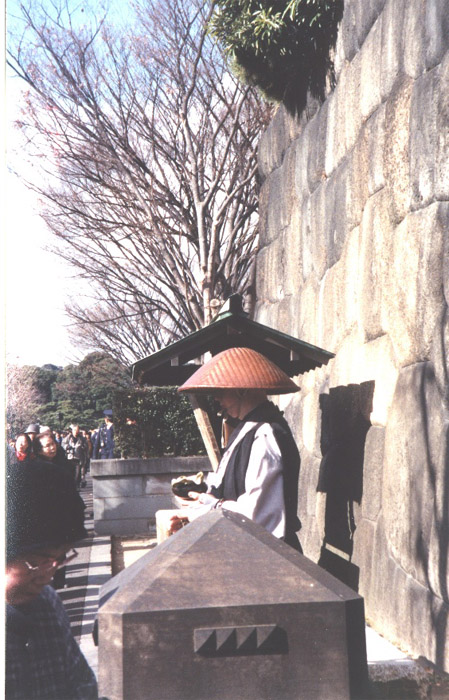
"Gaijin" monk near the Imperial Palace.
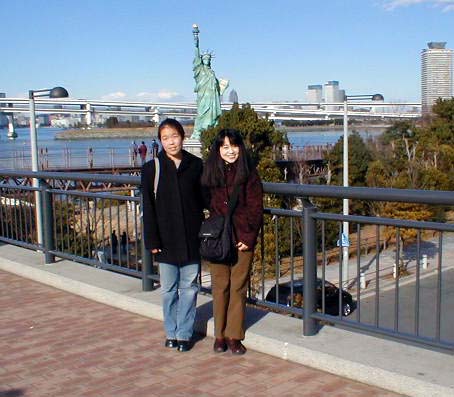
Kato-sensee and me, in front of a version of the Statue of Liberty ("Jiyuu no megamisama") at Odaiba, Tokyo Bay area.
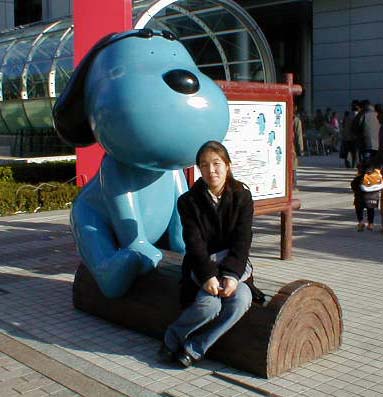
Me and a big blue dog in front of Fuji TV.
Tess Kim
tkim15@uic.edu
April 2, 2002








